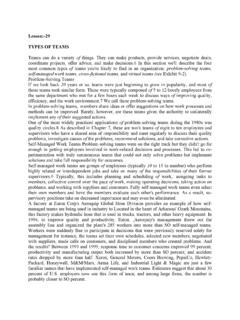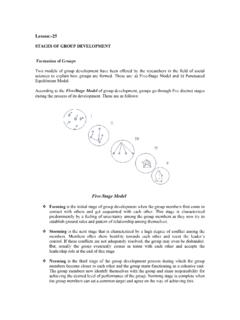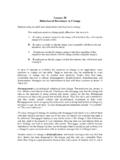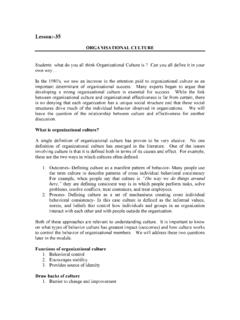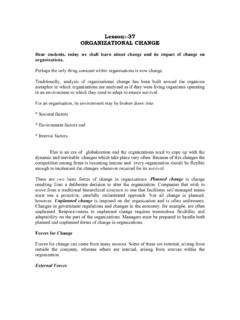Transcription of Lesson:-05 MANAGERIAL DECISION MAKING Types of …
1 Lesson:-05 . MANAGERIAL DECISION MAKING . Types of MANAGERIAL Decisions Chapter overview: Types of MANAGERIAL decisions, steps in DECISION - MAKING process Today, students, we are going to discuss a MANAGERIAL function that encompasses all the other functions of management, that is, MAKING decisions. A DECISION is a choice made from available alternatives. DECISION - MAKING is the process of identifying problems and opportunities and selecting a course of action to deal with a specific problem or take advantage of an opportunity. Managers often are referred to as DECISION makers MANAGERIAL DECISION - MAKING differs from personal DECISION MAKING in the systematic, specialized attention that managers give to DECISION - MAKING . DECISION - MAKING is not easy. It must be done amid ever-changing factors, unclear information, and conflicting points of view.
2 Good DECISION - MAKING is a vital part of good management, because decisions determine how the organization solves its problems, allocates resources, and accomplishes its goals. Although many of their important decisions are strategic, managers also make decisions about every other aspect of an organization, including structure, control systems, responses to the environment, and human resources. Plans and strategies are arrived at through DECISION MAKING ; the better the DECISION MAKING , the better the strategic planning. Managers scout for problems and opportunities, make decisions for solving or taking advantage of them, and monitor the consequences to see whether additional decisions are required. DECISION - MAKING deals with problems. A problem arises when an actual state of affairs differs from a desired state of affairs.
3 Examples of problem situations are: A deviation from past experience. A deviation from a set plan. Other people's problems or decisions. The performance of competitors. In many cases, a problem maybe an opportunity in disguise. It is not always clear whether a situation faced by a manager presents a problem or an B. Gleicher, a management consultant, defines a problem as something that endangers the organization's ability to reach its objectives, and an opportunity as something that offers the chance to exceed objectives. According to Peter Drucker, opportunities rather than problems are the key to organizational and MANAGERIAL success. Drucker observes that solving a problem merely restores normality, whereas the exploitation of opportunities leads to progress. Types of MANAGERIAL Decisions The first classification of personal and organizational decisions was suggested by Chester Barnard in his classic book: The functions of the Executive.
4 In his opinion, the basic difference between the two decisions is that personal decisions cannot ordinarily be delegated to others, whereas organizational decisions can often, if not always, be delegated'. Thus, a manager makes organizational decisions that attempt to achieve organizational goals and personal decisions that attempt to achieve personal goals. Personal decisions can affect the organization, as in the case of a senior manager deciding to resign. Another common way of classifying Types of decisions is according to whether they are basic or routine Basic decisions are those which are unique, one-time decisions involving long-range commitments of relative permanence or duration, or those involving large investments. Examples of basic decisions in a business firm include plant location, organization structure, wage negotiations, product line, etc.
5 Most top management policy decisions can be considered as basic decisions. Routine decisions are the everyday, highly repetitive management decisions which by themselves have little impact on the overall organization. However, taken together, routine decisions play a tremendously important role in the success of an organization. Examples of routine decisions include an accounting entry DECISION and a salesperson's DECISION on what territory to cover. Finally, most management decisions typically fall into one of two categories: programmed and nonprogrammed. Programmed decisions involve situations that have occurred often enough to enable DECISION rules to be developed and applied in the future. Programmed decisions are used for dealing with recurring organizational problems, whether complex or uncomplicated.
6 If a problem occurs repetitively and routinely, and a specific approach can be worked out for handling it, then it may be a candidate for programmed DECISION MAKING . 0predicted, and analyzed, a manager does not need to go to the trouble and expense of working up an involved DECISION process. Programmed DECISION MAKING is relatively simple and tends to rely heavily on previous solutions. Programmed decisions limit freedom because managers have less latitude in deciding what to do. However, programmed decisions save time and cost less (since discretion consumes time and money), allowing managers to devote attention to other, more important activities. Lower-level managers essentially confront familiar and repetitive problems;. therefore they most typically rely on programmed decisions such as policies, standard operating procedures, and rules.
7 Examples of programmed decisions are inventory of a given product to be maintained, salary range of a newly hired employee, and handling of customer defined and largely unstructured, and have important consequences for the organization. ! Nonprogrammed decisions deal with unusual or exceptional problems. If a problem has not come up often enough to be covered by a policy or is so important that it deserves special treatment, it must be handled as a nonprogrammed DECISION . Also, when a manager confronts an ill-structured problem, a custom-made, nonprogrammed response is required. Most of the problems that top managers of an organization confront are nonrecurring and illstructured. Hence, as a manager moves up the organizational hierarchy, the ability to make nonprogrammed decisions becomes important.
8 Deciding whether to acquire another organization or to sell off an unprofitable division, deciding which markets offer the most potential, or deciding how to allocate an organization's resources are examples of nonprogrammed decisions. Another classification of decisions relates to: Complexity of the problem in terms of the number of factors associated with it. The extent of certainty that can be placed with the outcome of a DECISION . Based on these two dimensions, four kinds of DECISION modes can be identified: Mechanistic, Analytical, Judgmental, and Adaptive. ! A mechanistic DECISION is one that is routine and repetitive in nature. ! It usually occurs in a situation involving a limited number of DECISION variables where the outcomes of each alternative are known. Most mechanistic DECISION problems are solved by habitual responses, standard operating procedures, or clerical routines.
9 In order to further simplify these mechanistic decisions, managers often develop charts, lists, matrices, DECISION trees etc. An analytical DECISION involves a problem with a larger number of DECISION variables , where the outcomes of each DECISION variable can be computed. Management science and operations research provide a variety of computational techniques like linear programming and statistical analysis that can be used to find optimal solutions. Many production and engineering problems are complex, but solutions can be found. A judgmental DECISION involves a problem with a limited number of DECISION variables, but the outcomes of DECISION alternatives are unknown. Many marketing, investment, and resource allocation problems come under this category. Good judgment is needed to increase the possibility of desired outcomes and minimize the possibility of undesired outcomes.
10 An adaptive DECISION involves a problem with a large number of DECISION variables, where outcomes are not predictable. Because of the complexity and uncertainty of such problems, DECISION makers are not able to agree on the nature or on DECISION strategies. Such ill-structured problems usually require the contributions of many people with diverse technical backgrounds. In such a case, DECISION and implementation strategies have to be frequently modified toaccommodate new developments in technology and the environment. DECISION MAKING under different states of nature: Every DECISION situation can be organized on a scale according to the availability of information and the possibility of failure. The four positions on the scale are certainty, risk, uncertainty, and ambiguity. ! DECISION MAKING under certainty occurs when a manager knows the precise outcome associated with each possible alternative or course of action.
